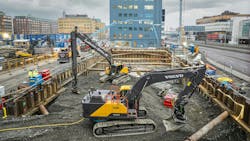Volvo Construction Equipment has teamed with organizations in its hometown of Gothenburg, Sweden, to test the viability of electric construction equipment in urban applications. The collaboration, “Electric Worksite,” tested various Volvo machines, including some prototypes, in real-life worksites around the city.
The project’s final report, “Electric Worksite II,” says that the electric machines fulfilled the same function and availability as equivalent fossil-powered machines. Both operators, supervisors, and other affected personnel reported “positive experiences of handling the machines, the working environment around the machines and also changed conditions such as ensuring charging and electricity supply.”
Read also: Job Site Charging Options for Electric Equipment
Equipment used in the project included electric-powered excavators and wheel loaders weighing between 3.5 and 30 tons, according to Volvo. The majority of the machines were in various prototype phases and that it was usually individual machines that were tested per construction site.
Who partnered on Electric Worksite?
- Volvo Construction Equipment
- NCC Sweden
- ABB Electrification Sweden
- Gothenburg City
- Chalmers University of Technology
- Lindholmen Science Park
- Gothenburg Energy
- Johanneberg Science Park
- Gothenburg City Leasing
- RISE Research Institutes of Sweden
- Riksbyggen
- HSB Gothenburg
- Halmstad University
The City of Gothenburg, the City Environment Administration, tested one or more machines in a number of different projects together with charging infrastructure and mobile energy storage, according to the report. The project goals included testing electric machines, energy storage, and charging infrastructure in different urban sites to clarify the varied needs across interconnected technical and organizational systems.
Machines were connected to the city electrical grid, but also used fast chargers. The machines worked on the construction of urban projects such as parks, playgrounds, bicycle racks, and roundabouts. A compact excavator was tested maintaining a railway supported by a mobile charging unit.
Volvo CE project managed the tests and provided electric machines in various sizes and models, as well as technical solutions for charging such as mobile energy storage and cable management systems.
NCC Infrastructure was a contractor partner in the project. Pernilla Löfås, sustainability manager, noted the importance of planning for the use of electric equipment on a project.
“Once again, we can conclude that the most important take-away is that we need to get involved early in the project to plan for electrification—because the opportunities to influence emissions are greatest in the planning stage,” she said in a statement. “To scale up the use of electric construction machines and vehicles, increased competence is also needed throughout the value chain. We also need electric machines to be demanded in the contracting by customers, and that they set requirements that drive the development forward.”
About the Author
Rod Sutton
Sutton served as the editorial lead of Construction Equipment from 2001 through 2025.

